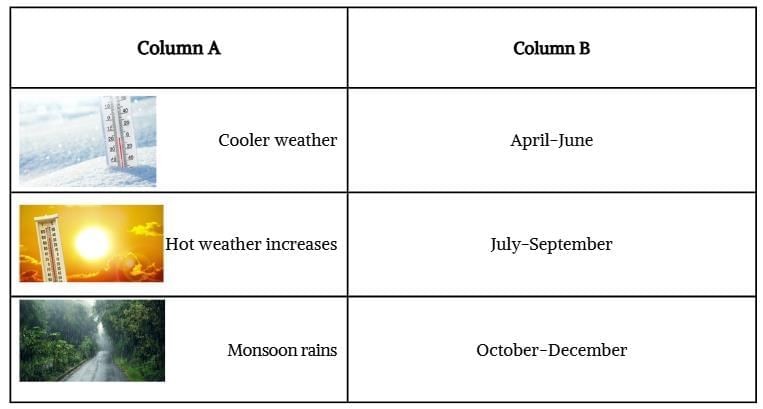Unit Test: Rhythms of Nature | Our Wondrous World Class 5 - New NCERT PDF Download
Time: 45 Minutes
M.M.: 20
Attempt all questions.
Question numbers 1 to 6 carry 1 mark each.
Question numbers 7 to 9 carry 3 marks each.
Question number 10 carries 5 marks.
Q1. The globe is a model of –
(a) Moon
(b) Earth
(c) Sun
(d) Star
Q2. Fill in the blanks:
In India, the six seasons are Vasanta (Spring), Grishma (Summer), Varsha (Monsoon), Sharad (Autumn), Hemant (Pre-winter), and ______ (Winter).
Q3. True or False:
The Sun moves around the Earth in one day.
Q4. Name any sign in nature that farmers might use to know rain is coming.
Q5. Match the following:
Q6. Which activity helps students observe seasonal patterns?
(a) Single-day quiz
(b) Seasons’ journal
(c) One-time field trip
(d) Only textbook reading
Q7. Write three ways seasons influence people’s daily lives.
Q8. Explain the torch-and-globe demonstration that shows day and night in three steps.
Q9. Why can winter in Kerala feel different from winter in Kashmir? Give three reasons.
Q10. Create a mini season’s chart for your region with observations for any three themes (plant life, birds/animals, air/heat/light, water bodies, human activities). Present one season in detail.
Find Solutions for the Unit Test - Here
|
11 videos|218 docs|10 tests
|
FAQs on Unit Test: Rhythms of Nature - Our Wondrous World Class 5 - New NCERT
| 1. What are the main principles of the rhythms of nature? |  |
| 2. How do the rhythms of nature impact ecosystems? |  |
| 3. Can human activities disrupt the rhythms of nature? |  |
| 4. What are some examples of natural rhythms observed in wildlife? |  |
| 5. How can students learn more about the rhythms of nature? |  |















